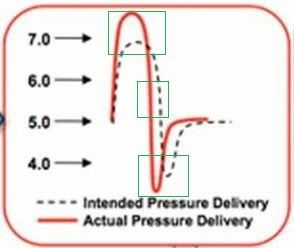palerider wrote:cpap pressure is a dynamic, active thing, affected by many factors, whether there's a humidifier (set automatically) whether there's an AB filter, size and length of hose, type of mask. all of these things resist airflow and cause pressure drops.
if the machine were to simply say "well, I've got 15cm at my pressure sensor, I'm good!" then you'd be having substandard treatment, because when you went to inhale, you'd NOT get 15cm of pressure to hold your airway open.
as you can see in the following diagram, the pressure generated at the machine isn't what ends up being experienced at the mask.

where intended pressure delivery is what's desired that the patient experience, and actual pressure is what's generated in the blower unit.
it has nothing to do with net volume, it has to do with fluid dynamics, with FLOW, flow through your airway and controlling the pressure dynamically so that you get the appropriate pressure in your face.
of course, the only way you could see that would be with high rate graphing manometers connected at the machine outlet, (before the humidifer) and inside the mask. my dual port manometer doesn't record data, and doesn't update fast enough to be able to make a chart, but it's easy to see the pressure differential on the two ends of the patient circuit.
Sorry, I'll try to be clearer.
Yes, the pressure in the mask is different from the pressure in the blower unit.
Yes, the machine does try to compensate for this and control the mask pressure, not just the blower unit pressure.
It's a little clearer if you ignore exhale relief for the moment.
The "mask resistance" refers to the resistance to flow between the air space in the mask and the patient's airway, not to the resistance to flow between the blower unit and the air space in the mask.
The average flow rate in the hose is equal to the leak rate of the mask.
The average flow rate in the patient's airway is zero. Air volume in must match air volume out. (Ignoring mouth leaks.)
The average pressure in the mask is not a function of the mask resistance or the tidal volume of the patient.
The machines try to maintain a controlled mask pressure, estimating the airflow resistance of the water tank and hose, and the flow rate in the hose.
Let's assume for the moment that the machine does a good job of controlling the mask pressure.
Assuming the pressure in the mask is at the "right" pressure, let's consider the effect of mask resistance.
During an apnea event, with no airflow, the pressure drop between the mask and the patient's airway is zero. By "Airway," I mean the inside of the patient's nose. Let's assume it's a nasal mask.
The pressure drop will also be zero at the end of the inhale or exhale cycle when flow drops to zero.
During these times, the patient will experience the pressure the blower unit is trying to provide. In particular, during an apnea event, the pressure will be "correct."
When the patient's airway is open and the patient is inhaling, there will be a difference between airway pressure and mask pressure. Note that this effect is low when the flow rate is low or restricted.
The airway pressure will be low during inhale and high during exhale. The average pressure will be the same.
There may be some slightly different effects when exhale relief is used, but they should be small. The effect of mask resistance will still drop to zero when airflow is zero. There may also be some small transient effects going from inhale to exhale.
Mask resistance probably affects the calculations the machines use to differentiate centrals from obstructive.
It's also possible that machines try to compensate for the mask resistance and keep the airway pressure constant during the middle of the inhale and exhale cycle. The pressure will still be "correct" when the airflow is low or zero.
Most importantly, the mask resistance is different from the other resistance because the vent rate of the mask doesn't figure in.
If you were using manometers to study the effect of "mask resistance," you'd need to put the manometer into the patient's nose, not the mask. Mask resistance affects the pressure drop between the mask and the patient's airway, not the pressure inside the mask.
